Being able to split a guitar signal into two amps is a great way to experiment with your tone, record different sounds, and play with stereo effects.
In this short guide, I’ll go through three simple methods you can use to split your guitar signal to two amps or other devices.
You can split a guitar signal to two guitar amps using an AB/Y pedal, a stereo effects pedal, or a multi-effects pedal. Each method has pros and cons and works best in different situations.
I’ll go through all three methods to help you decide which method is right for you.
Why You Would Want to Split a Guitar Signal
Being able to take your guitar signal and split it to two guitar amps or two different devices can be incredibly useful.
Here are some basic examples of what you can do when you split a guitar signal.
Play Through Two Guitar Amps at Once
If you’ve never played your guitar through two amps at the same time before, it might seem like a strange thing to do. But it’s a great way to add some depth to your tone.
When you play through two guitar amps, the tone you hear is very different from what a single guitar amp is capable of.
You can plug into two very different amps and blend the tone together to come up with something completely new. Or you can plug into two identical amps and slightly adjust each amp to produce a thicker and fatter different tone.
If you haven’t tried this before, you often end up with a tone that sounds fuller and more complex than a single guitar amp.

A great way to see the value of playing through two guitar amps at the same time is to try it out in a guitar modeling plugin such as AmpliTube 5.
A lot of guitarists have found that splitting the signal and running two guitar amps at the same time in AmpliTube 5 is a great way to enhance or add something interesting to your tones.
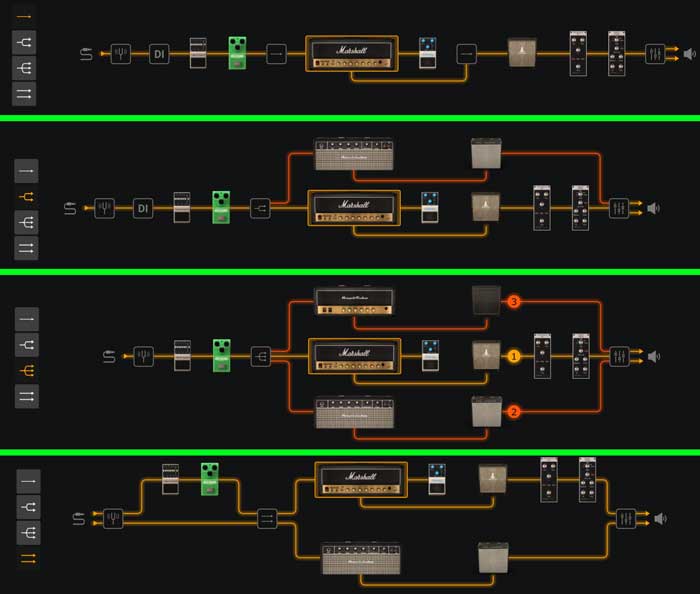
The above screenshots show different ways you can route your guitar signal into multiple guitar amps in AmpliTube. When you toggle between these different options it becomes obvious how useful it is to use multiple amps at once.
Learn more in my review of AmpliTube 5 here.
It’s the same with your physical guitar gear. Running your rig through two guitar amps is a fantastic way to enhance or add an interesting quality to your tones.
Record Your Guitar and Play Through an Amp
If you use an audio interface to record your guitar, you might want to consider using one of the four methods covered in this guide to split your guitar signal before it reaches the audio interface.
By splitting your guitar signal, you can plug your guitar into your audio interface as well as plug it into a guitar amp at the same time.
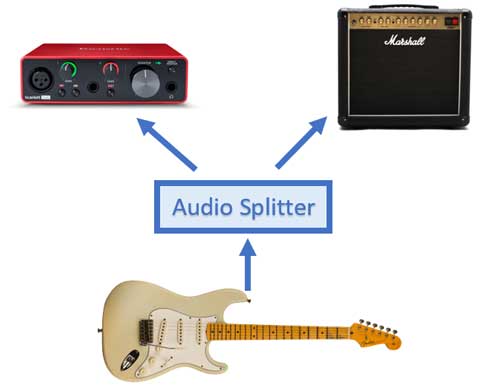
This means you can record your dry signal as well as hear your guitar through your amp while recording. Some audio interfaces like the AXE I/O by IK Multimedia have an amp output jack that can be used instead of splitting your guitar signal.
Or you can mic up your amp and record both the dry signal and the guitar amp through the mic at the same time.
If you enjoy recording guitar at home, I recommend buying one of the four methods covered in this guide so you can split your guitar signal while recording. It’s a handy tool you can use to give yourself more options when recording.
Learn more about recording guitar at home in this detailed guide.
Play Guitar With Stereo Guitar Effects
The majority of electric guitar effects are in mono as they are designed to be played through a single guitar amp.
But some guitar effects such as modulation, delay, and reverb often have stereo options that will work best when you use two guitar amps.
For example, ping-pong delay is when the delay sounds bounce back and forth between the left and right channels. This can create an impressively wide guitar tone that sounds amazing when used at home or in live performances.

Being able to plug into two guitar amps at the same time opens up a new world of guitar effects and tones.
Keep in mind that once you dive into stereo effects, you might have trouble going back to a regular mono guitar rig. There are many great options for effects and tones when running stereo, so buying stereo pedals can become addictive.
There are other reasons why you might want to split your guitar signal, but the above methods are the most common. Let’s now look at the different ways you can split your signal.
Method 1: AB/Y Splitter Pedal
The most common method of splitting a guitar signal so you can run it through two guitar amps is to use an AB/Y Splitter pedal.
An AB/Y Pedal is an incredibly useful tool to have on your pedalboard and can be used in many more ways than what I’ll cover in this guide.
The basic idea with an AB/Y Pedal is that you route your guitar signal to two different outputs separately (A/B) or at the same time (A+B) as shown below:
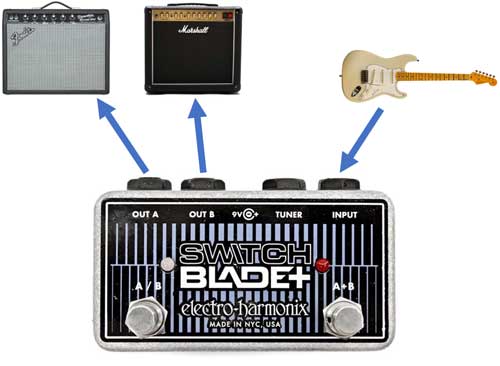

In the above diagram, you can use the ABY pedal to switch between three different routing options:
- Press the left ‘A / B’ footswitch to run the signal only through the A output (fender amp)
- Press the left ‘A / B’ footswitch again to run the signal only through the B output (Marshall amp)
- Press the right ‘A+B’ footswitch to split the signal and run through both the A and B outputs (fender and Marshall at the same time)
Hopefully, it’s clear how useful this can be when you want to run through different amps or pedals. You can easily set up a pedalboard that can make use of multiple amps or complex pedal chains and switch between them with ease.
If you have a lot of pedals or multiple guitar amps, I recommend buying an ABY pedal so you can experiment with different routing options. Plugging your guitar into two amps at the same time only scratches the surface of what is possible with an ABY pedal.
Recommended ABY Pedal
The Radial BigShot ABY Pedal is one of the best and most popular ABY pedals for a good reason. It’s a high-quality pedal that takes care of your tone and avoids noise issues you may experience with cheaper pedals.
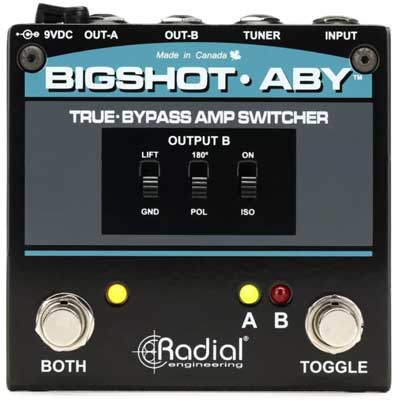

If you’re concerned at all about any tone-suck, signal loss, or noise when splitting your signal, this pedal is a great option.
Notice that this pedal has three switches: ground lift, polarization, and isolation.
These switches can make a big difference when it comes to noise and sound issues when plugging into two guitar amps at the same time.
The ground lift switch deals with a problem you may or may not experience when you connect your guitar to two amps at the same time. Some guitar amps can interfere with each other and cause electrical noise. The ground lift switch gives you a way of dealing with this issue and removing any ground noise.
Polarization is what can happen when you run identical signals through two speakers at a certain distance from each other. What happens is that the sound waves from the two amps can effectively cancel each other out. If you notice a big sound drop when you move your amps into position, that’s polarization at work. A polarization switch gives you a way of reversing the polarization of one of the signals so they don’t cancel each other out.
If you plan on playing through two guitar amps and spreading them out, getting a pedal with these options is recommended.
Check out the Radial BigShot ABY Pedal here on Amazon or here on Sweetwater.
Budget ABY Pedals
You might notice that some ABY pedals are quite expensive ($100-300), while other ABY pedals are cheap ($20-50). Why the big price difference?
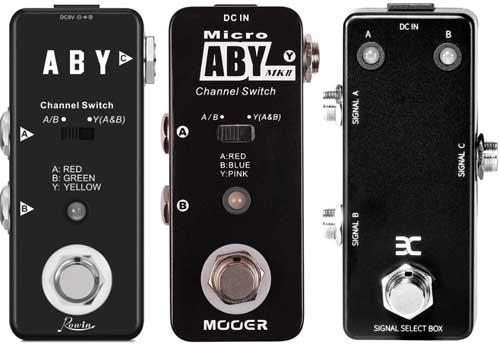

As you can see in the photo of the budget ABY pedals above, they don’t offer ground lift or polarization switches. This means you could experience issues when running into two amps at the same time.
If you position your amps in a way that causes polarization issues (large volume drop), there’s no polarization switch to solve the issue. You will need to move the amps until you hear the problem disappear.
If your amps interfere with each other, these budget ABY pedals don’t give you a way of dealing with the noise.
Of course, your amps may not have any issues at all and a budget ABY pedal will work perfectly fine. Just keep in mind that until you plug your guitar into the two amps at once, you won’t know if there are any grounding issues or not.
If you want to experiment with ABY pedals but don’t want to spend a lot, I recommend buying one of these budget pedals. They’re incredibly useful tools and even if your amps turn out to have grounding noise issues, you can use them in other ways in your pedalboard.
Check out some budget ABY pedals here.
Method 2: Stereo Guitar Effect Pedals
Depending on what pedals you have, you may already have a simple way of playing your guitar through two amps a the same time.
Many guitar pedals (especially reverb and delay pedals) offer stereo outputs. You can easily use these outputs to connect to two different guitar amps at the same time.
For example, the below MXR Stereo Chorus pedal has one input on the right side and two outputs on the left side:
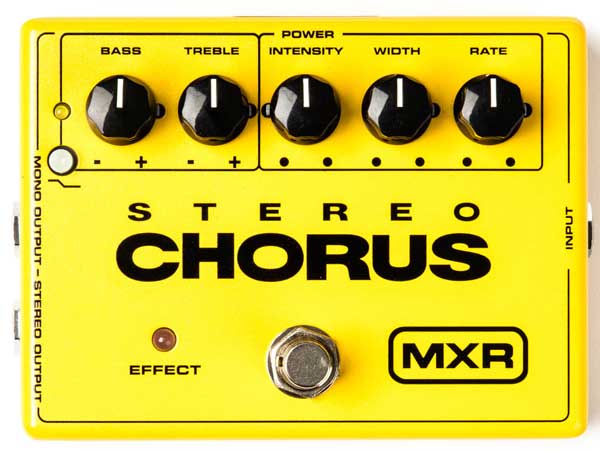

Other pedals may have stereo inputs and outputs such as the below Flashback II Delay by TC Electronic:


The idea with stereo inputs is that you can pass the signal from other stereo pedals into this pedal. So you can keep the stereo effect going through multiple pedals, then at the last pedal you can split off into two guitar amps.
Splitting your guitar signal to two amps using a stereo pedal is as simple as it gets. All you need to do is connect a second amp to the second output jack of the stereo pedal.



You can still use any pedals you want in your chain, but remember that you can only split your guitar signal from the stereo pedal position.
This means if you want to run your stereo pedal early in your signal chain, it will split the signal at that point. So think about your signal chain and how you would like to split your signal.
If you don’t have a stereo pedal but are interested in trying them out, I recommend checking out a stereo delay pedal (read this guide to learn everything about delay pedals).
Delay pedals are often the last pedal in a chain (unless you also use reverb pedals), which makes them an ideal pedal to split your signal to two guitar amps.
Delay is also an incredibly versatile effect that works great in essentially any style of music. Once you try out a ping-pong delay into two guitar amps spread across your room, you’ll get an idea of how useful stereo effects can be.
Method 3: Multi-Effects Pedal
A multi-effects pedal is a simple way of splitting your guitar signal to two guitar amps and it offers flexibility and features not available in the other methods.
Almost all popular multi-effects pedals will have stereo outputs you can use to connect to two amps.
Even the compact Line 6 HX Stomp has stereo inputs and outputs:


Splitting a guitar signal with a multi-effects pedal is as easy as connecting a second amp to the other output jack.
The big advantage of using a multi-effects pedal is that you can easily experiment with any stereo effects you want. You can create full stereo rigs and even use different amp models for each output (depending on the pedal).
Check out this guide on Line 6’s Multi-Effects Pedals to learn more.
Useful Guides
Here are some useful guides that give you more ways of using your gear:
- How to Play Guitar Without an Amp
- Using Headphones with Electric Guitar
- How to Record Guitar at Home
- Ultimate Guide to Guitar VST Plugins
